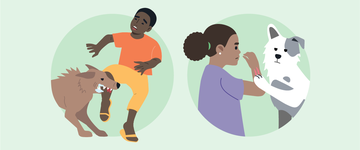Integrated bite case management
Let's dive into managing dog bites, which is crucial in areas where rabies is a risk.
Remember, the virus is found in the infected animal’s saliva, and it is the saliva that spreads it to humans.
👉🏽 First aid measures: When someone has been bitten by a dog, the first thing you should do is wash the wound immediately with soap and a lot of water for at least 15 minutes. If possible, wash with running water under a tap. If available, apply an antiseptic that kills viruses, such as iodine or ethanol, on the wound.
Cleaning the wound like this significantly reduces the risk of rabies by washing away and killing virus particles. It can be lifesaving in situations where it is not possible to get the patient to a clinic where the PEP vaccine and RIG can be given. After cleaning the wound, take the patient to the nearest healthcare facility as soon as possible.
👉🏽 At the local health facility: Do not suture the wound unless necessary. If suturing is necessary, delay it at least for a few hours after the administration of RIG (when such treatment is indicated) to allow for its infiltration. If suturing cannot be delayed, sutures should be loose and minimal.
Cover the wounds loosely. Vaccinate against tetanus unless the patient has received a tetanus vaccine within the last 10 years.
Investigate if other people in the community have been exposed to the same dog and assess their cases.
👉🏽 Referral for rabies PEP vaccination and assessment: Unless the dog’s owner has reliable documentation that it is up to date with rabies vaccination, refer the patient to a clinic where rabies PEP vaccination can be administered. Alternatively, request rabies PEP vaccine to be delivered to your clinic if you assess the patient can be managed locally. Ensure that the patient returns for vaccination the following day when rabies PEP has arrived.
Follow national clinical guidelines for the administration of rabies PEP vaccine and the number of doses.
👉🏽 Observe the dog/animal: If the dog or animal that bit your patient is alive, place it under observation. Animals with rabies die within 7-10 days after the onset of disease. If the animal is alive after 10 days, you can be confident that it does not have rabies. If the animal dies within 10 days, the likelihood is high that it died from rabies.
👉🏽 Find all exposed: Locate anyone who may have been bitten, scratched, or licked by the dog/animal suspected of having rabies, and ensure they receive rabies PEP vaccination.
For more information on how to contact the nearest health facility that provides rabies PEP vaccination, please refer to your local health authorities.
Click NEXT to learn more about reporting suspected rabies and cases of encephalitis.
Average Rating: ☆ ☆ ☆ ☆ ☆ (0 reviews)


